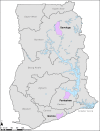Understanding the gap between access and use: a qualitative study on barriers and facilitators to insecticide-treated net use in Ghana
- PMID: 31831004
- PMCID: PMC6909499
- DOI: 10.1186/s12936-019-3051-0
Understanding the gap between access and use: a qualitative study on barriers and facilitators to insecticide-treated net use in Ghana
Abstract
Background: Mass and continuous distribution channels have significantly increased access to insecticide-treated nets (ITNs) in Ghana since 2000. Despite these gains, a large gap remains between ITN access and use.
Methods: A qualitative research study was carried out to explore the individual and contextual factors influencing ITN use among those with access in three sites in Ghana. Eighteen focus group discussions, and free listing and ranking activities were carried out with 174 participants; seven of those participants were selected for in-depth case study. Focus group discussions and case study interviews were audio-recorded, transcribed verbatim, and analysed thematically.
Results: ITN use, as described by study participants, was not binary; it varied throughout the night, across seasons, and over time. Heat was the most commonly cited barrier to consistent ITN use and contributed to low reported ITN use during the dry season. Barriers to ITN use throughout the year included skin irritation; lack of airflow in the sleeping space; and, in some cases, a lack of information on the connection between the use of ITNs and malaria prevention. Falling ill or losing a loved one to malaria was the most powerful motivator for consistent ITN use. Participants also discussed developing a habit of ITN use and the economic benefit of prevention over treatment as facilitating factors. Participants reported gender differences in ITN use, noting that men were more likely than women and children to stay outdoors late at night and more likely to sleep outdoors without an ITN.
Conclusion: The study results suggest the greatest gains in ITN use among those with access could be made by promoting consistent use throughout the year among occasional and seasonal users. Opportunities for improving communication messages, such as increasing the time ITNs are aired before first use, as well as structural approaches to enhance the usability of ITNs in challenging contexts, such as promoting solutions for outdoor ITN use, were identified from this work. The information from this study can be used to inform social and behaviour change messaging and innovative approaches to closing the ITN use gap in Ghana.
Keywords: Ghana; Insecticide-treated mosquito net; Malaria; Prevention.
Conflict of interest statement
The authors declared that they have no competing interests.
Figures
Similar articles
-
Barriers in distribution, ownership and utilization of insecticide-treated mosquito nets among migrant population in Myanmar, 2016: a mixed methods study.Malar J. 2019 May 14;18(1):172. doi: 10.1186/s12936-019-2800-4. Malar J. 2019. PMID: 31088451 Free PMC article.
-
The influence of caregiver's malaria-related knowledge on the use of insecticide-treated net among children under-five: a cross-sectional study.Malar J. 2024 Dec 18;23(1):374. doi: 10.1186/s12936-024-05203-7. Malar J. 2024. PMID: 39696443 Free PMC article.
-
Outdoor-sleeping and other night-time activities in northern Ghana: implications for residual transmission and malaria prevention.Malar J. 2015 Jan 28;14:35. doi: 10.1186/s12936-015-0543-4. Malar J. 2015. PMID: 25627277 Free PMC article.
-
Ownership and usage of insecticide-treated nets in Ghana: a scoping review of facilitators and barriers.Malar J. 2024 Aug 10;23(1):238. doi: 10.1186/s12936-024-05072-0. Malar J. 2024. PMID: 39127692 Free PMC article.
-
Ownership and use of insecticide-treated nets during pregnancy in sub-Saharan Africa: a review.Malar J. 2013 Aug 1;12:268. doi: 10.1186/1475-2875-12-268. Malar J. 2013. PMID: 23914731 Free PMC article. Review.
Cited by
-
Factors associated with the use of long-lasting insecticidal nets in pregnant women and mothers with children under five years of age in Gaza province, Mozambique.PLOS Glob Public Health. 2024 Jan 16;4(1):e0002811. doi: 10.1371/journal.pgph.0002811. eCollection 2024. PLOS Glob Public Health. 2024. PMID: 38227566 Free PMC article.
-
Family, social and cultural determinants of long-lasting insecticidal net (LLIN) use in Madagascar: secondary analysis of three qualitative studies focused on children aged 5-15 years.Malar J. 2021 Mar 26;20(1):168. doi: 10.1186/s12936-021-03705-2. Malar J. 2021. PMID: 33771162 Free PMC article.
-
Knowledge, attitude and practices of malaria preventive measures among mothers with children under five years in a rural setting of Ghana.Malar J. 2023 Sep 12;22(1):268. doi: 10.1186/s12936-023-04702-3. Malar J. 2023. PMID: 37700321 Free PMC article.
-
Unveiling the significance of women's role in health-seeking behavior during suspected malaria fever in risk populations of Nepal: Mixed methods cross-sectional study.PLOS Glob Public Health. 2024 Sep 4;4(9):e0003697. doi: 10.1371/journal.pgph.0003697. eCollection 2024. PLOS Glob Public Health. 2024. PMID: 39231131 Free PMC article.
-
Arbovirus Epidemiology: The Mystery of Unnoticed Epidemics in Ghana, West Africa.Microorganisms. 2022 Sep 27;10(10):1914. doi: 10.3390/microorganisms10101914. Microorganisms. 2022. PMID: 36296190 Free PMC article. Review.
References
-
- Ghana Health Service. Annual Report 2016. Accra, Ghana; 2017. https://www.ghanahealthservice.org/downloads/GHS_ANNUAL_REPORT_2016_n.pdf. Accessed 5 Jan 2019.
-
- Ghana Statistical Service (GSS), Ghana Health Service (GHS), and ICF. Ghana Malaria Indicator Survey 2016. Accra, Ghana, and Rockville, Maryland, USA, 2017.
-
- WHO . Global malaria control and elimination: report of a technical review. Geneva: World Health Organization; 2008.
-
- Appawu MA, Baffoe-Wilmot A, Afari EA, Dunyo SK, Koram KA, Nkrumah FK. Malaria vector studies in two ecological zones in southern Ghana. Afr Entomol. 2001;9:59–65.
MeSH terms
Grants and funding
LinkOut - more resources
Full Text Sources
Medical
Miscellaneous




